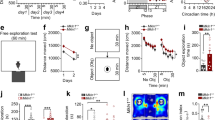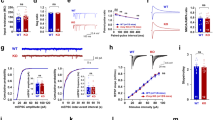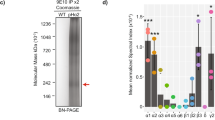Abstract
The pathogenesis of schizophrenia is believed to involve combined dysfunctions of many proteins including microtubule-associated protein 6 (MAP6) and Kv3.1 voltage-gated K+ (Kv) channel, but their relationship and functions in behavioral regulation are often not known. Here we report that MAP6 stabilizes Kv3.1 channels in parvalbumin-positive (PV+ ) fast-spiking GABAergic interneurons, regulating behavior. MAP6−/− and Kv3.1−/− mice display similar hyperactivity and avoidance reduction. Their proteins colocalize in PV+ interneurons and MAP6 deletion markedly reduces Kv3.1 protein level. We further show that two microtubule-binding modules of MAP6 bind the Kv3.1 tetramerization domain with high affinity, maintaining the channel level in both neuronal soma and axons. MAP6 knockdown by AAV-shRNA in the amygdala or the hippocampus reduces avoidance or causes hyperactivity and recognition memory deficit, respectively, through elevating projection neuron activity. Finally, knocking down Kv3.1 or disrupting the MAP6-Kv3.1 binding in these brain regions causes avoidance reduction and hyperactivity, consistent with the effects of MAP6 knockdown. Thus, disrupting this conserved cytoskeleton-membrane interaction in fast-spiking neurons causes different degrees of functional vulnerability in various neural circuits.
This is a preview of subscription content, access via your institution
Access options
Subscribe to this journal
Receive 12 print issues and online access
$259.00 per year
only $21.58 per issue
Buy this article
- Purchase on Springer Link
- Instant access to full article PDF
Prices may be subject to local taxes which are calculated during checkout








Similar content being viewed by others
References
Trubetskoy V, Pardiñas AF, Qi T, Panagiotaropoulou G, Awasthi S, Bigdeli TB, et al. Mapping genomic loci implicates genes and synaptic biology in schizophrenia. Nature. 2022;604:502–8.
Singh T, Poterba T, Curtis D, Akil H, Al Eissa M, Barchas JD, et al. Rare coding variants in ten genes confer substantial risk for schizophrenia. Nature. 2022;604:509–16.
Schizophrenia Working Group of the Psychiatric Genomics, C. Biological insights from 108 schizophrenia-associated genetic loci. Nature. 2014;511:421–7.
Genovese G, Fromer M, Stahl EA, Ruderfer DM, Chambert K, Landén M, et al. Increased burden of ultra-rare protein-altering variants among 4877 individuals with schizophrenia. Nat Neurosci. 2016;19:1433–41.
Martins-de-Souza D, Gattaz WF, Schmitt A, Rewerts C, Maccarrone G, Dias-Neto E, et al. Prefrontal cortex shotgun proteome analysis reveals altered calcium homeostasis and immune system imbalance in schizophrenia. Eur Arch Psychiatry Clin Neurosci. 2009;259:151–63.
Xiao B, Xu H, Ye H, Hu Q, Chen Y, Qiu W. De novo 11q13.4q14.3 tetrasomy with uniparental isodisomy for 11q14.3qter. Am J Med Genet A. 2015;167A:2327–33.
Shimizu H, Iwayama Y, Yamada K, Toyota T, Minabe Y, Nakamura K, et al. Genetic and expression analyses of the STOP (MAP6) gene in schizophrenia. Schizophr Res. 2006;84:244–52.
Wei H, Sun S, Li Y, Yu S. Reduced plasma levels of microtubule-associated STOP/MAP6 protein in autistic patients. Psychiatry Res. 2016;245:116–8.
Chen CP, Lin SP, Chern SR, Wu PS, Chen SW, Wu FT, et al. Tetrasomy of 11q13.4-q14.3 due to an intrachromosomal triplication associated with paternal uniparental isodisomy for 11q14.3-qter, intrauterine growth restriction, developmental delay, corpus callosum dysgenesis, microcephaly, congenital heart defects and facial dysmorphism. Taiwan J Obstet Gynecol. 2021;60:169–72.
Yanagi M, Joho RH, Southcott SA, Shukla AA, Ghose S, Tamminga CA. Kv3.1-containing K(+) channels are reduced in untreated schizophrenia and normalized with antipsychotic drugs. Mol Psychiatry. 2014;19:573–9.
Angelescu I, Kaar SJ, Marques R, Borgan T, Veronesse F, Sharman A, et al. The effect of AUT00206, a Kv3 potassium channel modulator, on dopamine synthesis capacity and the reliability of [(18)F]-FDOPA imaging in schizophrenia. J Psychopharmacol. 2022;36:1061–9.
Bosc C, Cronk JD, Pirollet F, Watterson DM, Haiech J, Job D, et al. Cloning, expression, and properties of the microtubule-stabilizing protein STOP. Proc Natl Acad Sci USA. 1996;93:2125–30.
Job D, Rauch CT, Margolis RL. High concentrations of STOP protein induce a microtubule super-stable state. Biochem Biophys Res Commun. 1987;148:429–34.
Pirollet F, Rauch CT, Job D, Margolis RL. Monoclonal antibody to microtubule-associated STOP protein: affinity purification of neuronal STOP activity and comparison of antigen with activity in neuronal and nonneuronal cell extracts. Biochemistry. 1989;28:835–42.
Cuveillier C, Boulan B, Ravanello C, Denarier E, Deloulme JC, Gory-Fauré S, et al. Beyond Neuronal Microtubule Stabilization: MAP6 and CRMPS, Two Converging Stories. Front Mol Neurosci. 2021;14:665693.
Lefevre J, Savarin P, Gans P, Hamon L, Clément MJ, David MO, et al. Structural basis for the association of MAP6 protein with microtubules and its regulation by calmodulin. J Biol Chem. 2013;288:24910–22.
Bosc C, Frank R, Denarier E, Ronjat M, Schweitzer A, Wehland J, et al. Identification of novel bifunctional calmodulin-binding and microtubule-stabilizing motifs in STOP proteins. J Biol Chem. 2001;276:30904–13.
Peris L, Bisbal M, Martinez-Hernandez J, Saoudi Y, Jonckheere J, Rolland M, et al. A key function for microtubule-associated-protein 6 in activity-dependent stabilisation of actin filaments in dendritic spines. Nat Commun. 2018;9:3775.
Andrieux A, Salin PA, Vernet M, Kujala P, Baratier J, Gory-Faure S. et al. The suppression of brain cold-stable microtubules in mice induces synaptic defects associated with neuroleptic-sensitive behavioral disorders. Genes Dev. 2002;16:2350–64.
Fournet V, Schweitzer A, Chevarin C, Deloulme JC, Hamon M, Giros B, et al. The deletion of STOP/MAP6 protein in mice triggers highly altered mood and impaired cognitive performances. J Neurochem. 2012;121:99–114.
Rudy B, McBain CJ. Kv3 channels: voltage-gated K+ channels designed for high-frequency repetitive firing. Trends Neurosci. 2001;24:517–26.
Kaczmarek LK, Zhang Y. Kv3 Channels: Enablers of Rapid Firing, Neurotransmitter Release, and Neuronal Endurance. Physiol Rev. 2017;97:1431–68.
Gu Y, Servello D, Han Z, Lalchandani RR, Ding JB, Huang K, et al. Balanced Activity between Kv3 and Nav Channels Determines Fast-Spiking in Mammalian Central Neurons. iScience. 2018;9:120–37.
Chi G, Liang Q, Sridhar A, Cowgill JB, Sader K, Radjainia M, et al. Cryo-EM structure of the human Kv3.1 channel reveals gating control by the cytoplasmic T1 domain. Nat Commun. 2022;13:4087.
Weiser M, Bueno E, Sekirnjak C, Martone ME, Baker H, Hillman D, et al. The potassium channel subunit KV3.1b is localized to somatic and axonal membranes of specific populations of CNS neurons. J Neurosci. 1995;15:4298–314.
Oliver KL, Franceschetti S, Milligan CJ, Muona M, Mandelstam SA, Canafoglia L, et al. Myoclonus epilepsy and ataxia due to KCNC1 mutation: Analysis of 20 cases and K(+) channel properties. Ann Neurol. 2017;81:677–89.
Cameron JM, Maljevic S, Nair U, Aung YH, Cogné B, Bézieau S, et al. Encephalopathies with KCNC1 variants: genotype-phenotype-functional correlations. Ann Clin Transl Neurol. 2019;6:1263–72.
Muona M, Berkovic SF, Dibbens LM, Oliver KL, Maljevic S, Bayly MA, et al. A recurrent de novo mutation in KCNC1 causes progressive myoclonus epilepsy. Nat Genet. 2015;47:39–46.
Li X, Zheng Y, Li S, Nair U, Sun C, Zhao C, et al. Kv3.1 channelopathy: a novel loss-of-function variant and the mechanistic basis of its clinical phenotypes. Ann Transl Med. 2021;9:1397.
Park J, Koko M, Hedrich UBS, Hermann A, Cremer K, Haberlandt E, et al. KCNC1-related disorders: new de novo variants expand the phenotypic spectrum. Ann Clin Transl Neurol. 2019;6:1319–26.
Xu M, Cao R, Xiao R, Zhu MX, Gu C. The axon-dendrite targeting of Kv3 (Shaw) channels is determined by a targeting motif that associates with the T1 domain and ankyrin G. J Neurosci. 2007;27:14158–70.
Xu M, Gu Y, Barry J, Gu C. Kinesin I transports tetramerized Kv3 channels through the axon initial segment via direct binding. J Neurosci. 2010;30:15987–6001.
Fradley RL, O’Meara GF, Newman RJ, Andrieux A, Job D, Reynolds DS. STOP knockout and NMDA NR1 hypomorphic mice exhibit deficits in sensorimotor gating. Behav Brain Res. 2005;163:257–64.
Parekh PK, Sidor MM, Gillman A, Becker-Krail D, Bettelini L, Arban R, et al. Antimanic Efficacy of a Novel Kv3 Potassium Channel Modulator. Neuropsychopharmacology. 2018;43:435–44.
Tortosa E, Adolfs Y, Fukata M, Pasterkamp RJ, Kapitein LC, Hoogenraad CC. Dynamic Palmitoylation Targets MAP6 to the Axon to Promote Microtubule Stabilization during. Neuronal Polarization Neuron. 2017;94:809–25.
McDonald AJ, Mascagni F. Differential expression of Kv3.1b and Kv3.2 potassium channel subunits in interneurons of the basolateral amygdala. Neuroscience. 2006;138:537–47.
Couegnas A, Schweitzer A, Andrieux A, Ghandour MS, Boehm N. Expression pattern of STOP lacZ reporter gene in adult and developing mouse brain. J Neurosci Res. 2007;85:1515–27.
Dotti CG, Sullivan CA, Banker GA. The establishment of polarity by hippocampal neurons in culture. J Neurosci. 1988;8:1454–68.
Gu Y, Jukkola P, Wang Q, Esparza T, Zhao Y, Brody D, et al. Polarity of varicosity initiation in central neuron mechanosensation. J Cell Biol. 2017;216:2179–99.
Nestler EJ, Barrot M, Self DW. DeltaFosB: a sustained molecular switch for addiction. Proc Natl Acad Sci USA. 2001;98:11042–6.
Barry J, Gu Y, Jukkola P, O’Neill B, Gu H, Mohler PJ, et al. Ankyrin-G directly binds to Kinesin-1 to transport voltage-gated Na+ channels into axons. Developmental Cell. 2014;28:117–31.
Gu C, Barry J. Function and mechanism of axonal targeting of voltage-sensitive potassium channels. Prog Neurobiol. 2011;94:115–32.
Tweedy C, Kindred N, Curry J, Williams C, Taylor JP, Atkinson P, et al. Hippocampal network hyperexcitability in young transgenic mice expressing human mutant alpha-synuclein. Neurobiol Dis. 2021;149:105226.
Maurer AP, Johnson SA, Hernandez AR, Reasor J, Cossio DM, Fertal KE, et al. Age-related changes in lateral Entorhinal and CA3 neuron allocation predict poor performance on object discrimination. Front Syst Neurosci. 2017;11:49.
Reagh ZM, Noche JA, Tustison NJ, Delisle D, Murray EA, Yassa MA. Functional imbalance of anterolateral entorhinal cortex and hippocampal Dentate/CA3 Underlies Age-related object pattern separation deficits. Neuron. 2018;97:1187–98.e1184.
Babaev O, Piletti Chatain C, Krueger-Burg D. Inhibition in the amygdala anxiety circuitry. Exp Mol Med. 2018;50:1–16.
Han S, Tai C, Westenbroek RE, Yu FH, Cheah CS, Potter GB, et al. Autistic-like behaviour in Scn1a+/− mice and rescue by enhanced GABA-mediated neurotransmission. Nature. 2012;489:385–90.
Jukkola P, Gu Y, Lovett-Racke AE, Gu C. Suppression of inflammatory demyelinaton and axon degeneration through inhibiting Kv3 channels. Front Mol Neurosci. 2017;10:344.
Rice J, Weiner JL, Coutellier L, Gu C. Region-specific interneuron demyelination and heightened anxiety induced by adolescent binge alcohol treatment. Acta Neuropathologica Commun. 2019;7:173.
Jukkola P, Guerrero T, Gray V, Gu C. Astrocytes differentially respond to inflammatory autoimmune insults and imbalances of neural activity. Acta Neuropathologica Commun. 2013;1:70.
Sun C, Qi L, Cheng Y, Zhao Y, Gu C. Immediate induction of varicosities by transverse compression but not uniaxial stretch in axon mechanosensation. Acta Neuropathol Commun. 2022;10:7.
Gu C, Zhou W, Puthenveedu MA, Xu M, Jan YN, Jan LY. The microtubule plus-end tracking protein EB1 is required for Kv1 voltage-gated K+ channel axonal targeting. Neuron. 2006;52:803–16.
Acknowledgements
We thank Drs. Howard Gu for technical assistance in stereotaxic injection, David Arnold for technical assistance in rotarod, Laurence Coutellier for consultation in behavioral testing, and OSU Neuroscience Image Core (P30NS104177) for technical assistance in confocal microscopy. This work was supported, in part, by grants from NIH (R01NS093073) to CG. All animal experiments have been conducted in accordance with the NIH Animal Use Guidelines. The authors declare no competing financial interests.
Author information
Authors and Affiliations
Contributions
CG designed and supervised the research; DM, SC, JB, RM, HL, and CG performed experiments and made the figures; TG and TM performed the SPR experiment. CB and AA provided critical reagents and revised the manuscript. DM and CG wrote and revised the manuscript.
Corresponding author
Ethics declarations
Competing interests
The authors declare no competing interests.
Additional information
Publisher’s note Springer Nature remains neutral with regard to jurisdictional claims in published maps and institutional affiliations.
Supplementary information
Rights and permissions
Springer Nature or its licensor (e.g. a society or other partner) holds exclusive rights to this article under a publishing agreement with the author(s) or other rightsholder(s); author self-archiving of the accepted manuscript version of this article is solely governed by the terms of such publishing agreement and applicable law.
About this article
Cite this article
Ma, D., Sun, C., Manne, R. et al. A cytoskeleton-membrane interaction conserved in fast-spiking neurons controls movement, emotion, and memory. Mol Psychiatry 28, 3994–4010 (2023). https://doi.org/10.1038/s41380-023-02286-7
Received:
Revised:
Accepted:
Published:
Issue Date:
DOI: https://doi.org/10.1038/s41380-023-02286-7



